The post Meet the New Sharks of 2015 first appeared on Deep Sea News.
]]>Another year of science closes, giving us pause to review those new species of sharks described in the scientific literature, bringing the total number of known shark species to 512. Perhaps it’s a hollow victory to have so many different species known at a time when sharks populations worldwide are either in decline or in a complete population tailspin. But as taxonomists continue to kick ass and give names, our knowledge of shark evolution, biogeography, and ecology continue to get richer. Meet the new sharks of 2015:
Ginglymostoma unami, the Pacific Nurse Shark
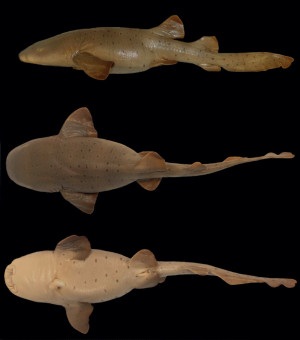 This isn’t really the brand-spankin’ new species you might think, but it has been known for well over a century. The Nurse Shark (Ginglymostoma cirratum) had a disjunct distribution between the Caribbean and Gulf of Mexico and the eastern central Pacific oceans, meaning their range was divided into two separate populations. Like some nooks in the Ozarks, land barriers prevented gene flow, so the populations were both physically and genetically separated by a small spit of land called Central America. This team didn’t use genetic methods to test if the populations were distinct enough to be considered different species, but relied on a meristics, the process of compiling detailed measurements of the shark’s anatomy and comparing these values between the populations. However, a 2012 paper on populations genetics of G. cirratum showed that the Pacific population was genetically quite unique, and divergent from any of the Atlantic populations. Since these two nurse shark populations had been separated by three million years, a few things can happen, like speciation. Indeed, their analysis showed that these two species are morphologically different enough to warrant giving the Pacific population its own scientific name. This name, G. unami, is an acronym of their alma mater, the Universidad Nacional Autonoma de Mexico.
This isn’t really the brand-spankin’ new species you might think, but it has been known for well over a century. The Nurse Shark (Ginglymostoma cirratum) had a disjunct distribution between the Caribbean and Gulf of Mexico and the eastern central Pacific oceans, meaning their range was divided into two separate populations. Like some nooks in the Ozarks, land barriers prevented gene flow, so the populations were both physically and genetically separated by a small spit of land called Central America. This team didn’t use genetic methods to test if the populations were distinct enough to be considered different species, but relied on a meristics, the process of compiling detailed measurements of the shark’s anatomy and comparing these values between the populations. However, a 2012 paper on populations genetics of G. cirratum showed that the Pacific population was genetically quite unique, and divergent from any of the Atlantic populations. Since these two nurse shark populations had been separated by three million years, a few things can happen, like speciation. Indeed, their analysis showed that these two species are morphologically different enough to warrant giving the Pacific population its own scientific name. This name, G. unami, is an acronym of their alma mater, the Universidad Nacional Autonoma de Mexico.
Scyliorhinus ugoi, Dark Speckled Catshark
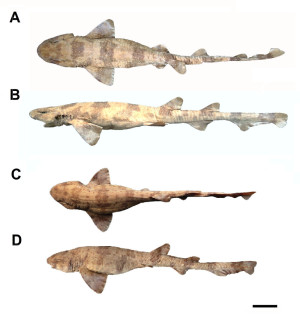 Way down among Brazilians sharks once swam there in the millions, but overfishing took surely took a hefty toll, yet there are still new shark species to be found. Case in point: a new catshark that had long been swimming along most of the Brazilian coast but had been confused as other known species. Catsharks are a widespread, diverse, and somewhat confusing group of sharks. Differences in color, morphological changes between juveniles & adults, and sexual differences between males & females create difficulties in sorting out just how many species there are. Here, the authors use detailed meristic analysis to extract out a species that had been there all along, but the morphological features that delineate the species had not yet been defined.
Way down among Brazilians sharks once swam there in the millions, but overfishing took surely took a hefty toll, yet there are still new shark species to be found. Case in point: a new catshark that had long been swimming along most of the Brazilian coast but had been confused as other known species. Catsharks are a widespread, diverse, and somewhat confusing group of sharks. Differences in color, morphological changes between juveniles & adults, and sexual differences between males & females create difficulties in sorting out just how many species there are. Here, the authors use detailed meristic analysis to extract out a species that had been there all along, but the morphological features that delineate the species had not yet been defined.
Atelomycterus erdmanni, Spotted-belly Catshark
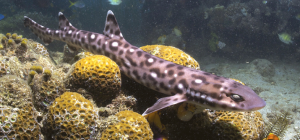
This sexy beast is one of the more colorful species of catsharks, and is one of several new species discovered from a larger taxonomic mess called the coral catsharks. Using meristics, genetics, and biogeographical analyses, it turns out that the “coral catshark” represents several species, with this species as the newest. They don’t live in coral, so much as they crawl on and among coral reefs of Indonesia, using their pectoral and pelvic fins like tiny feet and walking like a more limber and agile salamander. Named after Mark Erdmann, a fish taxonomist who collected most of the known specimens, and was rewarded with this li’l shark bearing his name.
Bythaelurus tenuicephalus, Narrow-head Catshark
 2015 also brought us two more catsharks, from the same genus, and both from the depths of the southwestern Indian Ocean. Hailing from the outer continental shelf of Mozambique and Tanzania comes the Narrow-headed catshark. The vast majority of sharks in recent years have been from the more remote pockets of Earth’s oceans, and in particular, from the deep oceans that have barely been explored. This species of Bythaelurus is a “dwarf”, a species that is sexually mature at a much smaller size than most other species in its genus. The advantage of dwarfism might allow this species to breed at a younger age, thus increasing their overall lifetime reproductive output. Or it could be that being smaller simply means eating smaller prey that larger species of catsharks might miss. This sort of niche-partitioning may explain why there are so many different species of catsharks. The species name tenuicephalus means “narrow head”, a little less imaginative than some names, but descriptive nonetheless.
2015 also brought us two more catsharks, from the same genus, and both from the depths of the southwestern Indian Ocean. Hailing from the outer continental shelf of Mozambique and Tanzania comes the Narrow-headed catshark. The vast majority of sharks in recent years have been from the more remote pockets of Earth’s oceans, and in particular, from the deep oceans that have barely been explored. This species of Bythaelurus is a “dwarf”, a species that is sexually mature at a much smaller size than most other species in its genus. The advantage of dwarfism might allow this species to breed at a younger age, thus increasing their overall lifetime reproductive output. Or it could be that being smaller simply means eating smaller prey that larger species of catsharks might miss. This sort of niche-partitioning may explain why there are so many different species of catsharks. The species name tenuicephalus means “narrow head”, a little less imaginative than some names, but descriptive nonetheless.
Bythaelurus naylori, Dusky Snout Catshark
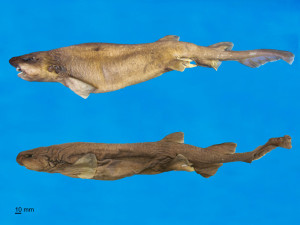 Another year, another catshark on the list. This species however, has quite an interesting story behind its capture. Massive trawlers, towing huge nets and pulling up tons of fish aren’t new, but what is new is the trend for these huge vessels to move from depleted fishing grounds in the shallows, and into the relatively untapped fishery resources of the deep sea. In addition to the targeted commercial species that will earn them great sums of money when they return to port, these nets also catch and kill tons of other non-marketable species. This is what ecologists call ‘by-catch’, but there is a sunny side to such needless destruction. Commercial vessels are often the first to explore deep-sea zones, well ahead of research cruises that are difficult to fund and even more impossible to sustain over time. If you can get onto one of these factory trawlers, the bounty of the bycatch is yours, and what a paradise this is to shark researchers. Dave Ebert & Paul Clerkin of the Pacific Shark Research Center at Moss Landing Marine Lab got the invite to board one of these vessels as it sailed south from Mauritius, but with a small catch: they had to stay for the entire three month trawling season. If you haven’t ever had the displeasure of sailing the wild waves and howling winds where the Indian Ocean meets the Southern Ocean, then you wouldn’t know that it makes The Deadliest Catch look like a Honolulu harbor cruise. Already hardened by the seas of the Gulf of Alaska, Paul made three of these cruises, collecting more than a dozen new species of skates, rays, sharks, and chimeras that will be published in future years. The species name naylori honors Gavin Naylor of the College of Charleston who, through genetic analysis, is compiling a more complete evolutionary history of extant shark species.
Another year, another catshark on the list. This species however, has quite an interesting story behind its capture. Massive trawlers, towing huge nets and pulling up tons of fish aren’t new, but what is new is the trend for these huge vessels to move from depleted fishing grounds in the shallows, and into the relatively untapped fishery resources of the deep sea. In addition to the targeted commercial species that will earn them great sums of money when they return to port, these nets also catch and kill tons of other non-marketable species. This is what ecologists call ‘by-catch’, but there is a sunny side to such needless destruction. Commercial vessels are often the first to explore deep-sea zones, well ahead of research cruises that are difficult to fund and even more impossible to sustain over time. If you can get onto one of these factory trawlers, the bounty of the bycatch is yours, and what a paradise this is to shark researchers. Dave Ebert & Paul Clerkin of the Pacific Shark Research Center at Moss Landing Marine Lab got the invite to board one of these vessels as it sailed south from Mauritius, but with a small catch: they had to stay for the entire three month trawling season. If you haven’t ever had the displeasure of sailing the wild waves and howling winds where the Indian Ocean meets the Southern Ocean, then you wouldn’t know that it makes The Deadliest Catch look like a Honolulu harbor cruise. Already hardened by the seas of the Gulf of Alaska, Paul made three of these cruises, collecting more than a dozen new species of skates, rays, sharks, and chimeras that will be published in future years. The species name naylori honors Gavin Naylor of the College of Charleston who, through genetic analysis, is compiling a more complete evolutionary history of extant shark species.
And lastly….
Etmopterus benchleyi, Ninja Lanternshark
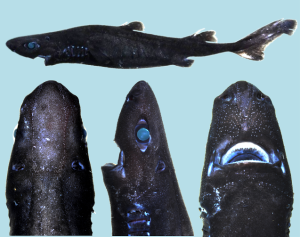 If you haven’t already seen this sassy new deepsea shark that went viral late last year, check it out here, and here, and here. That makes six new sharks for 2015, but new species will be discovered and described in 2016, so check back next year.
If you haven’t already seen this sassy new deepsea shark that went viral late last year, check it out here, and here, and here. That makes six new sharks for 2015, but new species will be discovered and described in 2016, so check back next year.
Etmopterus benchleyi n. sp., a new lanternshark (Squaliformes: Etmopteridae) from the central eastern Pacific Ocean: Journal of the Ocean Science Foundation; 17: 43-55.
The post Meet the New Sharks of 2015 first appeared on Deep Sea News.
]]>The post Deep-corals provide habitat for numerous associated species first appeared on Deep Sea News.
]]> Shallow water corals reefs have been called “the rainforests of the sea” because nooks and crannies created by reef building corals form micro-habitats for other animals, like trees in the rainforest create habitats for beetles and birds. On the coral reef, these niches are home to small mobile species like gobies, gastropods, shrimps, crabs, and seastars; and sessile fauna like bristleworms and sponges. A single 10cm radius colony of Oculina sp. in the shallow Gulf of Mexico can be home to >50 juvenile crabs.
Shallow water corals reefs have been called “the rainforests of the sea” because nooks and crannies created by reef building corals form micro-habitats for other animals, like trees in the rainforest create habitats for beetles and birds. On the coral reef, these niches are home to small mobile species like gobies, gastropods, shrimps, crabs, and seastars; and sessile fauna like bristleworms and sponges. A single 10cm radius colony of Oculina sp. in the shallow Gulf of Mexico can be home to >50 juvenile crabs.
The biodiversity of Lophelia pertusa bioherms in the North Atlantic rivals the diversity of a shallow water tropical reef (Rogers 1999). More than 800 associated species have been documented in association. L. pertusa and Oculina varicosa also provide nursery habitat for redfish Sebastes viviparous (Fossa et al., 2002), gag grouper Mycteroperca microlepsis, and scamp Mycteroperca phenax (Gilmore and Jones, 1992).
Gorgonian colonies are refuge to rockfish (left). Gorgonacea range to 6000m depth, and they are broadly distributed on continental shelves and seamounts wherever suitable substrate exists (Bayer 1956, 1961). So, any human activity that disturbs the seabed can be assumed to destroy anthozoan habitat in one form or another, unless proven otherwise.
This is important, because gorgonians create structural complexity in a relatively featureless environment, deeper than matrix forming scleractinia. They generate habitat for associated species of fish (Heifetz 2002, Etnoyer & Warrenchuk 2007), invertebrates (Krieger & Wing 2002, Buhl-Mortensen and Mortensen 2005), and microbial fauna (Penn et al 2006).
Deep gorgonians generate structure where you might not otherwise expect to find it, and they provide nursery habitat like bioherms do. Large Primnoa reseadeformis colonies have been photographed on the Olympic Coast with gravid dark blotched rockfish hiding in the branches (above). Catsharks in the Pacific Northwest lay their eggs on Plumarella sp., another primnoid type gorgonacean octocoral.
The question remains whether gorgonian habitat is obligate or facultative for the fishes (Auster, 2005). Do the catsharks need gorgonians specifically, or can they lay their eggs anywhere? We’re still not sure. However, there are few choices of substrate in the deep-sea, so coral may provide nursery habitat simply due to a lack of alternatives. Deep corals need protection from non-discriminate fishing gears and wreckless anchoring practices. Too many animals depend on these corals to justify careless destruction.
References:
Auster, P. 2005. Are deep-water corals important habitats for fishes? Pages 747-760 in A. Freiwald and J. M. Roberts, eds. Cold-water corals and ecosystems. Springer-Verlag Berlin Heidelberg.
Bayer, FM (1956) Octocorallia. In: Moore, RC (ed) Treatise on invertebrate paleonotology. Part F, Coelenterata. University of Kansas Press, Lawrence, Kansas, p 166-231
Bayer, FM (1961) The shallow-water Octocorallia of the West Indian region. A manual for marine biologists. Stud Fauna Curacao and other Caribbean Islands 12. Martinus Nijhoff, The Hague
Buhl-Mortensen L, Mortensen, PB (2005) Distribution and diversity of species associated with deep-sea gorgonian corals off Atlantic Canada. In: Freiwald A and Roberts JM (eds) Cold-water Corals and Ecosystems. Springer-Verlag, Heidelberg, p 849-879
Etnoyer P, Warrenchuk J (2007) A catshark nursery in a deep gorgonian field in the Mississippi Canyon, Gulf of Mexico. Bull Mar Sci. 81(3): 553-559.
Fossa, J. H., P. B. Mortensen, and T. M. Furevik. 2002. The deep-water coral Lophelia pertusa in Norwegian waters: distribution and fishery impacts. Hydrobiologia 471: 1-12.
Gilmore, R. G. and R. S. Jones. 1992. Color variation and associated behavior in the epihepheline groupers, Mycteroperca microlepis (Goode and Bean) and M. phenax Jordan Swain. Bull. Mar. Sci. 51: 83-103.
Heifetz, J (2002) Coral in Alaska: distribution, abundance, and species associations. Hydrobiologia 471:19-28
Krieger KJ, Wing BL (2002) Megafauna associations with deepwater corals (Primnoa spp.) in the Gulf of Alaska. Hydrobiologia 471: 82-90
Penn K, Wu D, Eisen JA, Ward N (2005) Characterization of Bacterial Communities Associated with Deep-Sea Corals on Gulf of Alaska Seamounts. App Env Microbiol 72(2): 1680-1683
Rogers, AD. 1999. The biology of Lophelia pertusa (Linnaeus 1758) and other deep-water reef-forming corals and impacts from human activities. International Review of Hydrobiology 84(4):315-406.
The post Deep-corals provide habitat for numerous associated species first appeared on Deep Sea News.
]]>